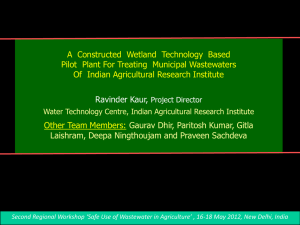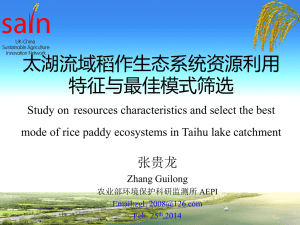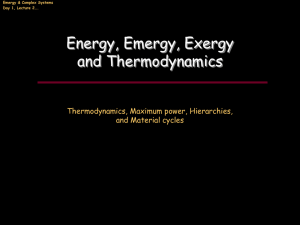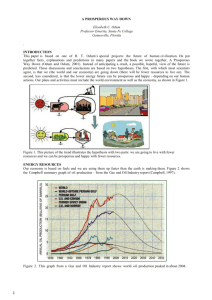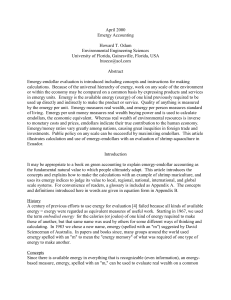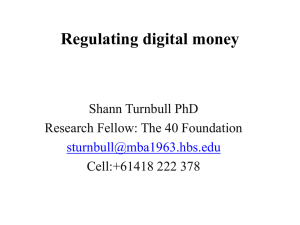Lecture 9: Environmental Impact Assessment
advertisement
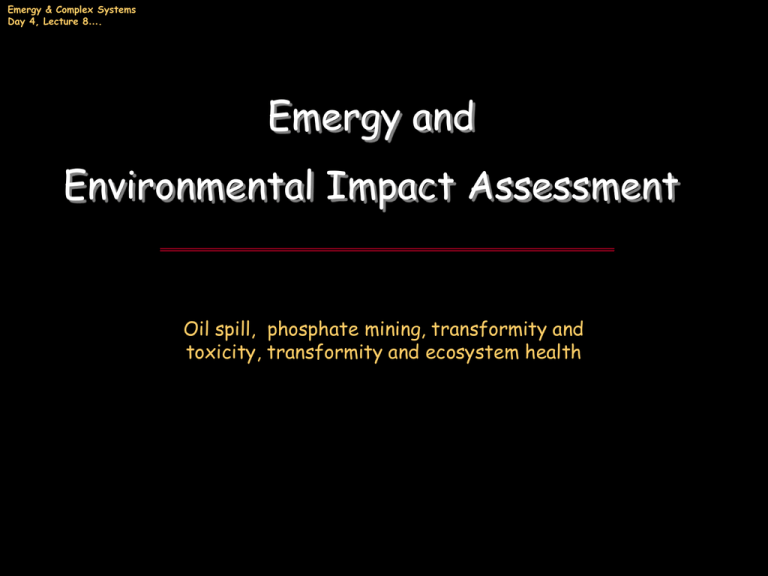
Emergy & Complex Systems Day 4, Lecture 8…. Emergy and Environmental Impact Assessment Oil spill, phosphate mining, transformity and toxicity, transformity and ecosystem health Emergy & Complex Systems Day 4, Lecture 8…. Environmental Impacts on Terrestrial Ecosystems... Emergy & Complex Systems Day 4, Lecture 8…. Environmental Impacts on Marine Ecosystems... Emergy & Complex Systems Day 4, Lecture 8…. Emergy Ratios for Assessing Environmental Impact Emergy & Complex Systems Day 4, Lecture 8…. Comparison of Development Alternatives Imports from Main Economy F1 F2 F2 R2 Env Source R R1 New Use Original Use to be diverted R3 P3 Alternate P2 P1 R1 *ELR R1 Potential P4 Emergy & Complex Systems Day 4, Lecture 8…. Emergy Evaluation of Exxon Valdez Oil Spill Emergy & Complex Systems Day 4, Lecture 8…. On March 24, 1989, the Exxon Valdez grounded on Bligh Reef, and spilled nearly 11 million gallons of oil into the biologically rich waters of Prince William Sound. Emergy & Complex Systems Day 4, Lecture 8…. Emergy & Complex Systems Day 4, Lecture 8…. Map of Alaska showing the Trans-Alaska pipeline... Emergy & Complex Systems Day 4, Lecture 8…. Map showing the extent of the oil spill in Gulf of Alaska... Emergy & Complex Systems Day 4, Lecture 8…. Two estimates of damages resulting from the oil spill... Percent of the total losses Emergy & Complex Systems Day 4, Lecture 8…. Distribution of the loss estimates... Emergy & Complex Systems Day 4, Lecture 8…. Oil spill losses compared to regional emergy budgets... Emergy & Complex Systems Day 4, Lecture 8…. Net benefits from prevention alternatives… Emergy & Complex Systems Day 4, Lecture 8…. The role of information in Exxon-Valdez oil spill Emergy & Complex Systems Day 4, Lecture 8…. I. Phosphate Mining and Reclamation Description, historical perspective, phosphate facts... Emergy & Complex Systems Day 4, Lecture 8…. Summary of Phosphate Mining System Emergy & Complex Systems Day 4, Lecture 8…. Secondary area of mining (50,000 acres) Main phosphate formation… the “bone valley” (1.3 million acres) Emergy & Complex Systems Day 4, Lecture 8…. Historical Perspective Mining began in late 1800’s Mined Peace River bottom Until late 1930’s small scale - wide spread Large scale mining began in 1950’s Currently about 5000 acres /year are mined Emergy & Complex Systems Day 4, Lecture 8…. Phosphate mining facts... Mined area to date………………….320,000 acres Mining rate…………………...5 - 6,000 acres/yr Total to be mined…….….700,000 acres Investment in facilities………...$10 billion Yearly wages…………………………….$300 million/yr Taxes paid………………………………..$800 million/yr Operating expenses (2001) Equip and supplies……….$990 million Electricity…………………….$100 million Services………………………..$178 million Emergy & Complex Systems Day 4, Lecture 8…. Phosphate Mining vs. Everglades Restoration Phosphate Reclamation Everglades Restoration Total Area 0.7 million Acres 1.5 million acres Total cost $3.6 billion $7.8 billion Yearly Op. Costs $0.0 $182 million Emergy & Complex Systems Day 4, Lecture 8…. II. Quick Photographic Overview Emergy & Complex Systems Day 4, Lecture 8…. Emergy & Complex Systems Day 4, Lecture 8…. Emergy & Complex Systems Day 4, Lecture 8…. Emergy & Complex Systems Day 4, Lecture 8…. Emergy & Complex Systems Day 4, Lecture 8…. Emergy & Complex Systems Day 4, Lecture 8…. Emergy & Complex Systems Day 4, Lecture 8…. Emergy & Complex Systems Day 4, Lecture 8…. Emergy & Complex Systems Day 4, Lecture 8…. Emergy & Complex Systems Day 4, Lecture 8…. Emergy & Complex Systems Day 4, Lecture 8…. Emergy & Complex Systems Day 4, Lecture 8…. Emergy & Complex Systems Day 4, Lecture 8…. Emergy & Complex Systems Day 4, Lecture 8…. Emergy & Complex Systems Day 4, Lecture 8…. Emergy & Complex Systems Day 4, Lecture 8…. Emergy & Complex Systems Day 4, Lecture 8…. Emergy & Complex Systems Day 4, Lecture 8…. Emergy & Complex Systems Day 4, Lecture 8…. Emergy & Complex Systems Day 4, Lecture 8…. Emergy & Complex Systems Day 4, Lecture 8…. Emergy Evaluation of Phosphate Mining and Reclamation Emergy & Complex Systems Day 4, Lecture 8…. Systems View and Emergy of Mining Emergy & Complex Systems Day 4, Lecture 8…. Emergy in Restoration... Plant Material Earth Moving Inf or. Services 1.5 3.0 Sun 12.0 1.2 Ecosystem Services Ecosystems Structure Spoil Soils 160 acres (assumes 100 years) E 18 sej Emergy & Complex Systems Day 4, Lecture 8…. Benefits of Restoration... Rain Tr anspir at ion P 3.8 gd. P H2 O 1.3 sej E22 sej Mining 6,000 O. M. Sun E19 Mt / ac A cid P H2 O Veget at ion . PO5 Calcium Car bonat e 160 acres Gross Primary Production (E 14 sej.ac./yr.) Mining Occurs 3.0 E14 sej/ac/yr 3 .0 1 .5 Production w ith Reclamation Production w ithout Reclamation 0 0 100 200 Years 300 400 500 Emergy & Complex Systems Day 4, Lecture 8…. Benefits of Restoration... Plant Mat erial Eart h Moving Inf or. Services 1.5 Mining 3.0 Gross Primary Production (E 14 sej.ac./yr.) Sun Ecosy st em Services 12.0 Ecosy st em s Sp o i l St ruct ure 1.5 Product ion wit h Reclam at ion 0 Net Product ion wit hout Reclam at ion 0 acres (assumes 100 3.0 E14 sej/ ac/ yr 3.0 So i l s 160 Occurs 1.2 years) Benefit E 18 sej 100 200 300 400 Years of Reclamat ion: Loss wit hout Reclamat ion = 3.0 E14 sej/ ac/ yr * 160 ac * 500 yr * 0.5 = 1 2 .0 E1 8 sej Loss wit h Reclamat ion = 3.0 E14 sej/ ac/ yr * 160 ac * 100 yr * 0.5 = 2 .4 E1 8 sej Net benefit reclamat ion = 12.0 E18 sej - 2.4 E18 sej = 9 .6 E1 8 sej 500 Emergy & Complex Systems Day 4, Lecture 8…. Net Benefits Ratio... Plant Mat erial Eart h Moving Inf or. Services 1.5 Mining 3.0 Ecosy st em Services 12.0 Ecosy st em s Sp o i l St ruct ure Gross Primary Production (E 14 sej.ac./yr.) Sun Occurs 3.0 1.5 Product ion wit h Reclam at ion So i l s 160 Product ion wit hout Reclam at ion 0 acres 0 (assumes 100 3.0 E14 sej/ ac/ yr 1.2 years) 100 E 18 sej 200 300 Years Net Benefit of Reclamat ion: Reclamation costs = 1.5 + 3.0 + 1.2 = 5 .7 E1 8 sej Reclamat ion benefit s = 9 .6 E1 8 sej Net benefit rat io = 9 .6 / 5 .7 = 1 .6 8 / 1 400 500 Emergy & Complex Systems Day 4, Lecture 8…. Transformity and Toxicity Emergy & Complex Systems Day 4, Lecture 8…. Transformity and Toxicity Transformities of selected metals as global flows to atmosphere and storages within a river ecosystem Aluminum Iron Chromium Arsenic Lead Cadmium Mercury Annual releases to atmosphere (seJ/J) River ecosystem (seJ/J) 9.65E+06 8.46E+07 2.59E+10 8.56E+11 2.39E+12 1.52E+13 6.85E+14 3.30E+07 6.19E+07 1.99E+10 -3.59E+10 8.78E+10 -- a - Not including human release b - Genoni et al. 2003 Emergy & Complex Systems Day 4, Lecture 8…. Transformity and Toxicity As transformities (emergy intensities) increase their potential effect within ecosystem increases. Effects can be both positive and negative. Transformity does not suggest the outcome that might result from the interaction of a stressor within an ecosystem, only that with high transformity, the effect is greater. Emergy & Complex Systems Day 4, Lecture 8…. Transformity and Toxicity The ultimate ultimate effect or toxin is not only related The effectofofa pollutant a pollutant or toxin is not onlyto its transformity, but more importantly to its concentration or related to its transformity, more importantly 2) in the to its emergy density (emergy per unitbut area, i.e. seJ/m concentration or empower density (emergy per unit ecosystem. area per unit time, i.e. seJ/m2*day) in the ecosystem. Where density a stressor is significantly Whereempower emergy density of aofstressor is significantly higher than higher than emergy the average densityitofisthe ecosystem the average densityempower of the ecosystem released into, expectinto, significant changes in ecosystem itone is can released one can expect significantfunction. changes in ecosystem function. Emergy & Complex Systems Day 4, Lecture 8…. Transformity and Toxicity For instance, using the transformity of mercury in the previous Table and the exergy of mercury (Szargut et al. 1988) one can convert the transformity to a specific emergy of 3.7 E17 sej/g. Using this specific emergy, and a mercury concentration of 0.001 ppb (the level the EPA considers to have chronic effects on aquatic life) the emergy density of the mercury in a lake would be 3.7 E12 sej/m2. Emergy Density of Florida Ecosystems is about 1.0 E9 sej/m2 Emergy & Complex Systems Day 4, Lecture 8…. Landscape Development Intensity (LDI) Index Emergy & Complex Systems Day 4, Lecture 8…. System Diagram of Landscape Development Impacts Wetland Condition Index Emergy & Complex Systems Day 4, Lecture 8…. Landscape Development Intensity… 100.0 90.0 80.0 70.0 60.0 50.0 40.0 30.0 20.0 10.0 0.0 0. 0 1 .0 2. 0 3. 0 4. 0 5. 0 6. 0 7. 0 8. 0 Human Disturbance Gradient 9. 0 1 0.0 Independent measure of disturbance using land use/land cover, aerial photographs, and ground observations Emergy & Complex Systems Day 4, Lecture 8…. Landscape Development Intensity… Based on intensity of human use Intensity measured by nonrenewable energy flow. Energy expressed in the same quality. Energy flow characteristics determined per hectare of various land use types. Emergy & Complex Systems Day 4, Lecture 8…. Land Use, Non-Renewable Empower Density, and Resulting LDI Coefficients Land Use Non-Renewable LDI Empower Density Coefficients (E14 sej/ha/yr) Natural EcoSystem 0. 00 1.00 Natural Open water 0. 00 1.00 Pine Plantation 5.10 1.58 Recreational / Open Space (Low-intensity) 6. 55 1.83 Woodland Pasture (with livestock) 8. 00 2. 02 Pasture (without livestock) 1 7.20 2. 77 Low Intensity Pasture (with livestock) 33.31 3. 41 Citrus 44.00 3. 68 High Intensity Pasture (with livestock) 46.74 3. 74 Row crops 1 07.1 3 4. 54 Single Family Residential (Low-density) 1,077. 00 6. 79 Recreational / Open Space (High-intensity) 1,230. 00 6. 92 High Intensity Agriculture (Dairy farm) 1,349. 20 7. 00 Single Family Residential (M ed-density) 2,175.00 7. 47 Single Family Residential (High-density) 2,371.80 7. 55 Mobile Home (Medium density) 2,748.00 7. 70 Highway (2 lane) 3,080.00 7. 81 Low Intensity Comm ercial 3,758.00 8. 00 Institutional 4,042.20 8. 07 Highway (4 lane) 5,020.00 8. 28 Mobile Home (High density) 5,087.00 8. 29 Industrial 5,210. 60 8. 32 Multi-family Residential (Low rise) 7,391.50 8. 66 High Intensity Comme rcial 1 2,661.00 9.18 Multi-family Residential (High rise) 1 2,825. 00 9.19 Central Business District (Average 2 stories) 1 6,1 50.30 9. 42 Central Business District (Average 4 stories) 29,4 01.30 1 0.00 Land Use Development Intensity Coefficients... Emergy & Complex Systems Day 4, Lecture 8…. Representative LDI Coefficients Land use LDI-Coeff. Natural landscape Tree plantation Pasture Agriculture Residential uses Roadways Commercial/Industrial uses 1.0 1.6 3.0 - 3.7 4.0 - 5.0 6.0 - 8.3 7.8 - 8.5 8.0 - 10.0 Emergy & Complex Systems Day 4, Lecture 8…. LDI = (LDIj * %LUj) Where, LDI = Landscape Development Intensity Index LDIj = LDI coefficient for land use “j” %LUj = Percent area of the wetland drainage basin occupied by land use “j” Emergy & Complex Systems Day 4, Lecture 8…. Landscape Development Intensity… TN (kg/ha-yr) Total Nitrogen Load 22 20 18 16 14 12 10 8 6 4 2 0 0 1 2 3 4 5 LDI 6 7 8 9 10 Emergy & Complex Systems Day 4, Lecture 8…. Landscape Development Intensity… Total Phosphorus Load 3.5 TP (kg/ha-yr) 3 2.5 2 1.5 1 0.5 0 0 1 2 3 4 5 LDI 6 7 8 9 10 Emergy & Complex Systems Day 4, Lecture 8…. Landscape Development Intensity… Total Suspended Solids Load 700 TSS ( kg/ha/yr ) 600 500 400 300 200 100 0 0 1 2 3 4 5 LDI 6 7 8 9 10 Emergy & Complex Systems Day 4, Lecture 8…. Landscape Development Intensity… LDI and Wetland Rapid Assessment “Score” 10 9 8 WRAP 7 6 5 4 Agricultural Reference Urban 3 2 1 0 0 1 2 3 4 5 LDI 6 7 8 9 10 Emergy & Complex Systems Day 4, Lecture 8…. Landscape Development Intensity… 1 00 Reference Agricultural Urban Florida WCI 80 60 40 20 0 0 1 2 3 4 5 LDI 6 7 8 9 10 Emergy & Complex Systems Day 4, Lecture 8…. Global Ecosystem Health as a Function of Landscape Development Intensity?? Emergy & Complex Systems Day 4, Lecture 8…. Global Estimate of Ecological Health Landscape De v e lopme nt In t e n sit y LDI 9 - 10 8- 9 5- 7 4- 5 3- 4 2- 3 1- 2 1.0 % Impaired 90% 80% 60% 50% 40% 30% 20% 0 - 10% Emergy & Complex Systems Day 4, Lecture 8….
